This article provides an overview of the carriage of liquefied gases by sea, including the most common cargoes and the history and safety record of the liquefied gas shipping and terminal industry.
A liquefied gas is the liquid form of a substance that would be a gas if it were at ambient temperature and at atmospheric pressure.
Most liquefied gases are hydrocarbons and the key property that makes hydrocarbons the world’s primary energy source, combustibility, also makes them inherently hazardous. Because these gases are handled in large quantities it is considered imperative that all practical steps are token to manage risk and, in particular, to avoid loss of containment and limit all sources of ignition.
For example, one metric tonne of liquefied natural gas (LNG) will occupy approximately 600 times less volume than one metric tonne of natural gas in vapour form. For liquefied petroleum gas (LPG), the ratio is one metric tonne of liquefied product will occupy approximately 400 times less volume than one metric tonne of petroleum gas in vapour form.
The most important property of a liquefied gas, in relation to pumping and storage, is its saturated vapour pressure (SVP) (see article “Properties of liquefied gasesSaturated vapour pressure (SVP)“). This is the absolute pressure exerted when a liquid is in equilibrium with its own vapour at a given temperature.
The International Maritime Organization (IMO) for the purposes of its Gas Carrier Codes, (see article “LNG vessel typesLiquefied Gases Carrier Types“) has adopted the following definition for liquefied gases carried by sea:
Liquids with a vapour pressure exceeding 0,28 MPa at a temperature of 37,8 °C
A characteristic of a liquefied gas that is often provided is the temperature at which the SVP is equal to atmospheric pressure. This is the liquid’s atmospheric boiling point (see Table 1).
| Table 1. Atmospheric boiling point of certain liquefied gases | |
|---|---|
| Liquefied Gas | Boiling Point at Atmospheric Pressure (°С) |
| Methane | minus 162 (-162) |
| Propane | minus 42,3 (-42,3) |
| Butane | minus 0,5 (-0,5) |
| Ammonia | minus 33,4 (-33,4) |
| Vinyl chloride (VCM) | minus 13,8 (-13,8) |
| Butadiene | minus 5 (-5) |
| Ethylene | minus 103,8 (-103,8) |
| Ethane | minus 88,6 (-88,6) |
The importance of understanding the implications of both of these characteristics will be explained in article “Liquefied Natural Gas PropertiesProperties of Liquefied Gases“.
The Liquefied Gases
The relationships between natural gas, natural gas liquids (NGLs) and LPGs are shown in Figure 1.
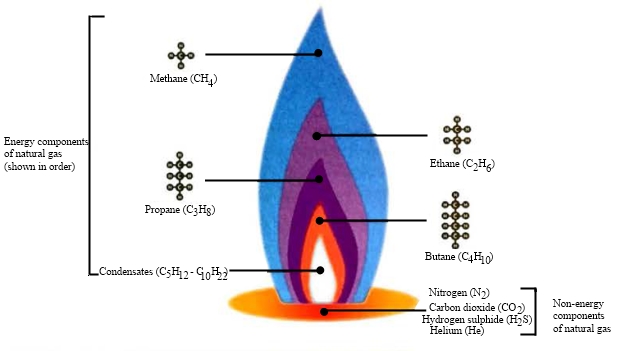
LPG can be either a byproduct of refining or obtained directly from NGL. LNG is only ever naturally produced.
LNG production
The demand for natural gas is rising and is expected to continue to rise, primarily because of its use as a clean burning fuel.
Natural gas reserves are distributed fairly evenly worldwide, providing more choices for importers that make them less dependent on supplies of other fossil fuels. The current demand and the near- term projected future demand for energy cannot be met by renewable energy technologies alone, so LNG provides an attractive alternative to other fossil fuels.
Natural gas may be found in:
- Underground wells that are mainly gas bearing;
- condensate reservoirs;
- large oil fields.
In oil wells, the natural gas may be in solution with the crude oil or it may sit as a gas cap above it. Natural gas contains small quantities of heavier hydrocarbons, which are collectively known as NGLs. This is in addition to varying amounts of water, carbon dioxide (CO2), nitrogen and other non-hydrocarbon substances.
The proportion of NGLs contained in raw natural gas varies from one location to another. However, NGLs are generally smaller percentages of the overall natural gas in gas wells than they are in condensate or crude oil reservoirs. Regardless of origin, natural gas requires treatment to remove the heavier hydrocarbons and non-hydrocarbon substances, to ensure it is in an acceptable condition for liquefaction or for use as a fuel.
Figure 2 is a flow diagram for a typical liquefaction plant (known as a “train“) used to produce Liquefied Natural GasLNG. In order to liquefy methane gas, its temperature must be reduced to about minus 162 °C (-162 °C), which is its atmospheric boiling point.
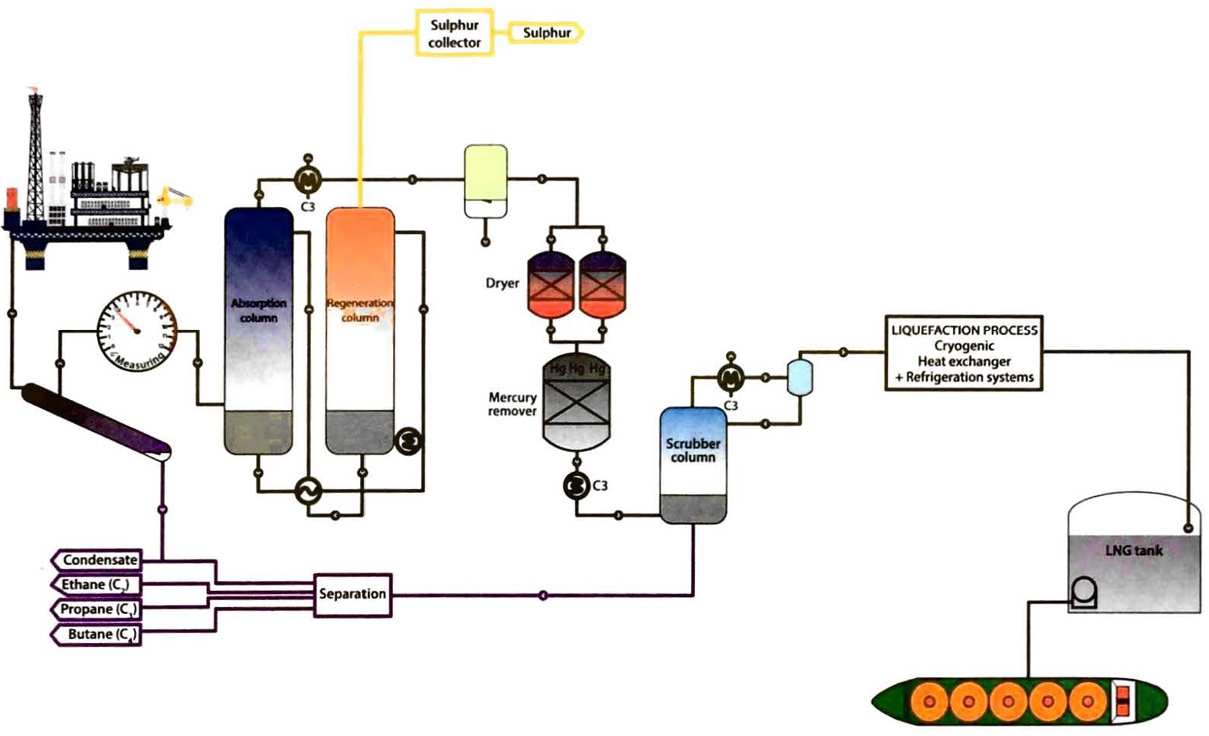
The liquefaction process is a complex refrigeration cycle, consisting of compressors (driven by steam or gas turbines, or electrical motors) and heat exchangers, where heat from the incoming gas is transferred to the working fluid of the cycle, which in turn transfers heat to an outside coolant. There are a number of proprietary processes for natural gas liquefaction, several of which are unique in design, yet they all perform common tasks:
- Treatment of the gas to remove impurities, such as mercury (Hg), to prevent corrosion problems;
- removal of acid gases such as hydrogen sulphide (H2S) and CO2, primarily to prevent corrosion problems (H2S is also an atmospheric pollutant when burnt in a fuel; CO2 is considered a pollutant as well as a greenhouse gas (GHG) and it will also freeze during the cryogenic process);
- dehydration, to prevent freezing of any entrained water during the cryogenic process;
- heavy oil/compound separation.
The thermodynamics of liquefaction will be further discussed in article “LNG vessel typesLiquefied Gases Carrier Types“, but the LNG processes can be classified broadly into three groups:
- Cascade liquefaction process.
- Mixed refrigerant processes.
- Turbine based processes.
Liquefaction processes in operation have a wide range of complexity and differ in efficiency and size. By adding units or cycles the efficiency may increase, but the size and weight will also increase. Onshore facilities can generally have a higher equipment count and an opportunity for larger amounts of hydrocarbon storage. As a result, their efficiency, and production rate, is high.
By contrast, offshore facilities will have constrictions of weight and space. A further discussion of offshore facilities can be found in article “Equipment and cargo system of LNG onshore terminalsThe Terminal“.
LPG is e general name given for propane, butane and mixtures of the two. These products can be obtained from the refining of crude oil and, when produced in this way, they ore usually manufactured in pressurised form.
Read also: Transportation of the Petroleum Gas and Amonia Cargoes on the Fully-Refrigerated LPG Ships
The main production of LPG is found in petroleum producing countries. At these locations, LPG is extracted from natural gas or crude oil streams coming from underground reservoirs.
In o natural gas well, the row product consists mainly of methane. However, as shown in Figure 2, it is normal for LPG to be produced as o byproduct of G processing, depending on the natural gas composition and e required quality specification of the LNG.
Figure 3 shows how e LPGs, ofter processing, are pumped to terminal storage tanks prior to shipmen for export.
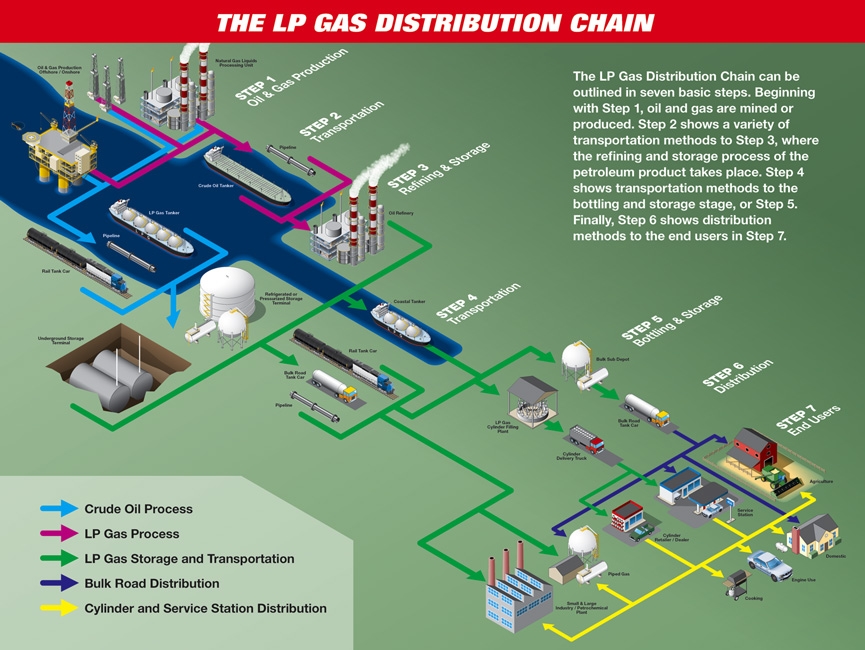
Chemical gases production
A simplified diagram for the production of the most common chemical gases, vinyl chloride monomer (VCM), ethylene and ammonia, is shown in Figure 4. These three chemical gases can be produced indirectly from propane. The propane is first cracked catalytically into methane and ethylene, and in some cases, ethane. The ethylene stream can then be synthesised with chlorine to manufacture VCM.
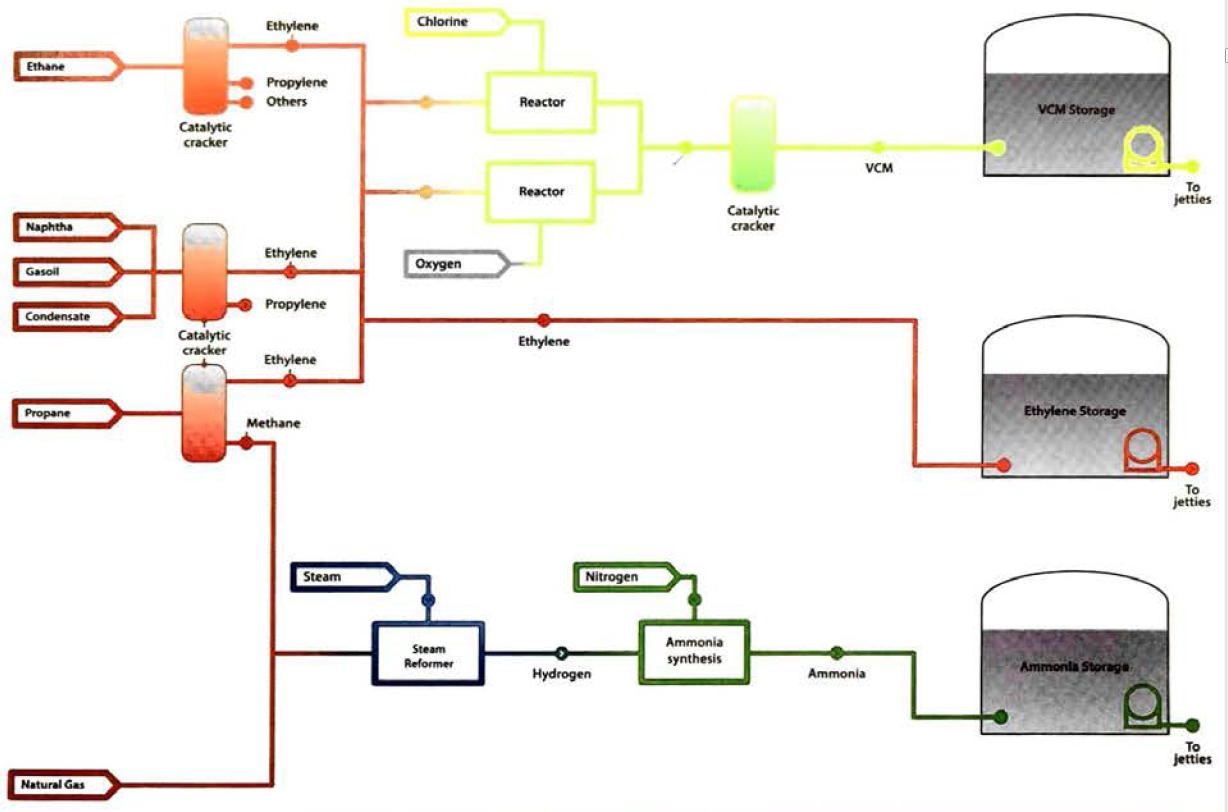
VCM can also be produced directly from the cracking of ethane or a combination of naphtha, gasoil and condensate.
Development of Natural Gas Liquefaction Cycles based on Energy and Exergy Analyses
Natural gas, or the methane stream resulting from the cracking of propane, is reformed with steam into hydrogen and then combined with nitrogen under high pressure and temperature, in the presence of a catalyst, to produce ammonia.
The Principal Products
While the hydrocarbon gases (methane, ethane, propane and butane) may be regarded principally as fuels, they are also important as feedstocks in the production of the chemical gases.
LNG: Liquefied natural gas is a major commodity in the world energy market. The composition of natural gas is a function of both the gas source and the type of processing it undergoes prior to liquefaction. The liquefaction process, which removes impurities and most of the heavier NGLs, results in a very clean LNG product. Methane is by far the major component of LNG and is usually, though not always, greater than 85 % by volume. LNG may still, however, contain small amounts of ethane, propane, butane, other heavier hydrocarbons and nitrogen. The differences in composition will result in variations in the heating value of the respective LNG product. The term “lean LNG” generally means LNG with high methane content while the term “rich LNG” generally means LNG with a lower methane content.
NGLs: Natural gas liquids are light hydrocarbons dissolved within natural gas in a hydrocarbon reservoir. The NGLs are made up of ethane, LPGs and gas condensates. NGLs should not be confused with gas to liquids (GTL), which is a refinery process to convert natural gas or other gaseous hydrocarbons into longer-chain hydrocarbons such as gasoline or diesel fuel.
GTL plants do, however, have the ability to strip methane from the gas stream and to load raw NGLs onto semi-refrigerated gas carriers. In such cases, the ships are modified with additional compressor capacity for shipment to customers able to accept ethane-rich cargoes. The NGLs are typically carried at minus 80 °C (-80 °C) temperature and atmospheric pressure, or at minus 45 °C (-45 °C) at a vapour pressure of 5 bar.
LPG: Liquefied petroleum gases comprise propane, butanes and mixtures of the two. LPG can exist in a liquid state at conditions of ambient temperatures and moderate pressure (less than 1,5 MPa). The main uses for LPG are as fuel for power generation, for industrial purposes such as metal cutting and as a petrochemical feedstock.
Butane, which is stored in cylinders and is known as bottled gas, has widespread use as a fuel for heating and cooking in remote locations. It is generally considered to be a basic source of heat/fuel for developing nations. It is an important octane enhancer for motor gasoline and a key petrochemical feedstock. Propane is also utilised as a bottled gas, especially in cold climates (to which its vapour pressure is more suited).
Ammonia: Ammonia can be used directly as fertiliser or can be the raw material used in the production of nitrogen containing fertilisers. It is also used as an onshore industrial refrigerant, in the production of explosives and in the manufacture of numerous industrial chemicals, such as urea.
Ammonia is the third largest seaborne trade in liquefied gases after LNG and LPG and is shipped in large parcels on fully-refrigerated carriers.
Ethylene: Ethylene is one of the primary petrochemical building blocks. It is used in the manufacture of polyethylene plastics, ethyl alcohol, polyvinyl chloride (PVC), antifreeze, polystyrene and polyester fibres. It is manufactured by cracking either naphtha, ethane or LPG.
Ethane: The majority of the ethane that is extracted, from either natural gas processing or as a byproduct from petroleum refining, is used as feedstock for ethylene production. The remainder is generally used as fuel.
Propylene: Propylene is a petrochemical intermediate used to make polypropylene and polyurethane plastics, acrylic fibres and industrial solvents.
Butadiene: Butadiene is a highly reactive petrochemical intermediate. It is used to produce styrene, acrylonitnle and polybutadiene synthetic rubbers. Butadiene is also used in paints and binders for non-woven fobrics and in plastic and nylon production. Most butadiene is a byproduct of the cracking of naphtha to produce ethylene.
VCM: Vinyl chloride monomer is an easily liquefiable, chlorinated gas used in the manufacture of PVC, the second most important thermoplastic in terms of output. VCM not only has a relatively high boiling point, at minus 14 °C (- 14 °C), but it is also, with a specific gravity of 0,97, much denser than the other common gas carrier cargoes. Around 10 % of the annual worldwide VCM production is carried by ship.
Gas Carrier Fleet
Gas carriers range from small pressurised ships of 500 to 11 000 m3 capacity, used for the shipment of propane, butane and chemical gases at ambient temperature, to the fully-refrigerated very large gas carriers (VLGCs) of greater than 80 000 m3 capacity used for the transport of LPGs and ethane, and the Qatari “Q Max” LNG carriers of 266 000 m3 capacity.
Between these distinct types is a third ship type, the semi-refrigerated gas carrier. These very flexible ships are able to carry many cargoes in a fully-refrigerated condition at atmospheric pressure, or at temperatures corresponding to carriage pressures of 5 to 9 bar.
The movement of liquefied gases by sea is a mature industry that is served by a fleet of over 1 600 ships, a worldwide network of export and import terminals and a wealth of knowledge and experience on the part of its workforce.
Gas carriers have a number of design features in common with ships such as oil tankers, which are required to have wing and double bottom ballast tanks located to give protection to the cargo.
The objective is to protect against the spillage of hazardous cargo in the event of a grounding or collision.
Because of the simplicity of the design and the range of worldwide trading opportunities, more fully-pressurised (FP) LPG carriers have been built than any other type of gas carrier. The FP fleet is engaged in the distribution of liquefied gases to virtually every country with a coastline. FP ships are among the smallest of the gas carriers and tend to serve regional trades.
The design parameters for pressurised cargo tanks remain essentially as they were in 1931, when the first gas cargo tanks were installed onboard the pioneering tanker Agnita. The major difference being that the cargo tanks on the Agnita were of riveted construction, while welded construction is now the norm. Because the cargo tanks are, essentially, pressure vessels for carrying cargoes under pressure at or near ambient temperature, mild steel is used and no tank/piping insulation or reliquefaction plant is required. Tanks are typically designed based on a minimum cargo temperature of minus 5 °C (-5 °C) and a maximum design pressure of 17 to 18 bar.
Suggested reading: Overview of Alternative Propulsion Systems for the LNG Vessel
A feature that is almost unique to the gas carrier is that the cargo tanks are kept under positive pressure to prevent air entering the cargo system. This means that only cargo liquid and cargo vapour are present in the cargo tank, ensuring that flammable atmospheres cannot develop.
Furthermore, all gas carriers utilise “closed” cargo systems when loading or discharging, with no venting of vapours allowed to the atmosphere. In the LNG trade, provision is made for the use of a vapour return line, between the ship and shore, to pass vapour that is displaced by the cargo transfer. In the LPG trade the use of vapour return lines is less common as, under normal circumstances during loading, reliquefaction is used to retain vapour on board. By these means cargo release to the atmosphere is virtually eliminated and the risk of vapour ignition is minimised (see article “Equipment and cargo system of LNG onshore terminalsVapour return“).
There is considerable variation in the design, construction and operation of gas carriers due to the differences in the cargoes carried and the number of cargo containment systems utilised. Cargo containment systems may be of the independent tank type (pressurised, semi-refrigerated or fully-refrigerated ship types) or of the membrane type (fully-refrigerated ship types) (see article “Liquefied Gas Carrier TypesGas Carrier Types“).
At about the same time as the development of fully-refrigerated LPG carriers, naval architects were facing a challenge. This was the transport of LNG, which is often produced far from the centres of consumption, making pipelines uneconomical. Because a gas in its liquefied form occupies much less space, and because of the critical temperature of liquefied methane, the ocean transport of LNG only makes sense from a commercial viewpoint. If it is earned in a liquefied state at atmospheric pressure.
Because of this it represents a greater engineering challenge than shipping LPG, mainly because it has to be carried at its boiling point, minus 162 °C (- 162 °C).
The first cargo of LNG was carried across the Atlantic in 1959 on the vessel Methane Pioneer and, by 1964, the first purpose-built LNG carriers, Methane Princess and Methane Progress, were in service under a long-term gas purchase agreement. LNG carrier size and containment system technologies have developed considerably since those early days.
LNG is increasingly being carried as a cargo at sea in International Organization of Standardization (ISO) containers on conventional container ships. The carriage of such containers is governed by the “International Maritime Dangerous Goods (IMDG) Code” (Reference 1.5).
With vast reserves, the Arctic is integral to the LNG industry’s growth, but moving natural gas from ice covered Arctic regions is extremely challenging. LNG carriers have to clear a path through layers of ice as much as two metres thick, creating a need for Arctic Class LNG carriers that are more powerful than conventional LNG carriers and built to an ice class of ARC 7 for operation in outside air temperatures of minus 40 °C (-40 °C).
Since 2000, the LNG industry has become more diverse, with small-scale multi-gas carriers, floating regasification and reliquefaction vessels, floating storage units, alternative propulsion types (to the traditional steam turbine), and ship to ship transfers becoming an integral part of LNG shipping. These areas will be discussed in detail in other parts of this publication.
Safety Record
Since the mid-1930s, when LPG shipping began, through to the mid-1960s when commercial transportation of LNG began, and into the present day, the gas shipping industry has built up an impressive safety record.
This safety record is due to reasons that include, but are not limited to, a strong, overarching safety philosophy, robust design of equipment and systems, good operational and maintenance procedures, operating in excess of the minimum requirements and to best practice, high standards of training coupled with competency verification, the fact that the IGC Code was developed based on actual experience in the early days of LNG transport and an ability to share lessons learnt and to develop best practices as an industry through the industry body.
However, there ore many challenges in the liquefied gas industry, including the supply of ships’ crews, shore support staff and trainers to meet the additional numbers of trained and competent staff required for the increased Reet size. The SIGTTO competency standards for crews onboard both LNG and LPG carriers hove become the industry best practice recommendation (References 2.1 to 2.3). These provide operators with guidance on the specific competencies each individual may need to possess before serving in that rank. The standards exceed the current minimum Standards of Training, Certification and Watchkeeping (STCW) requirements and there is also guidance available for terminal operators for their staff.
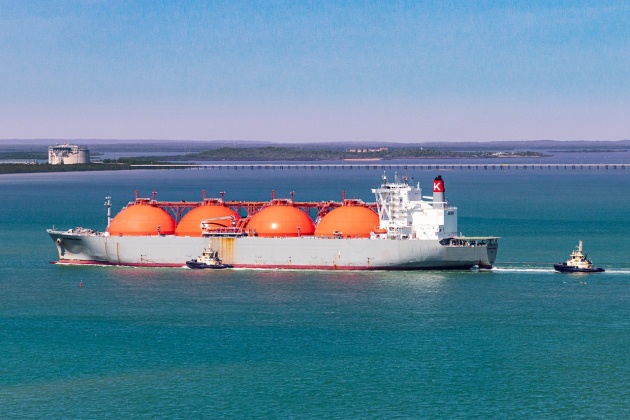
Источник: Pixabay.com
In comparison to most other ship types, gas carriers have a better safety record. However, casualty statistics involving gas carriers demonstrate that the risk of a serious accident is potentialy greater when the ship is in port than when at sea. For this reason it is appropriate that attention will, in large part, concentrate on the part facilities and the activities of ship and shore personnel involved in cargo operations.
The ship/shore interface is the area where the activities of personnel on the ship and shore overlap during cargo handling. Actions on one side of the interface will affect the other party and responsibility for safe operations does not stop at the cargo manifold for either ship or shore personnel.
Liquefied gas cargo handling procedures can be complex and the cargo itself is potentially hazardous. For these reasons, personnel operating gas carriers and gas berths require a thorough understanding of ship and shore equipment and cargo properties. It is prudent for them to have good operating procedures available to avoid accidents and for emergency plans to be in place in case an accident does occur.
Regulatory Framework
The primary document governing the carriage of liquefied gases is the “International Code for the Construction and Equipment of Ships Carrying Liquefied Gases in Bulk“, known as the IGC Code (References 1.1 and 1.2). It is issued and maintained by the IMO. There are other international regulations that impact the design and operation of gas carriers, and the following is an introduction to the key documents.
Safety of Life at Sea (SOLAS)
While SOLAS (Reference 1.6) is mostly known for general safety regulations, it is also the parent Convention for the IGC Code.
In November 1975, the “Code for the Construction and Equipment of Ships Carrying Liquefied Gases in Bulk“, known as the GC Code (Reference 1.3) was the first Code developed by the IMCO (the original name of the IMO) having direct applicability to gas carriers. The intention was to provide:
a standard for the safe bulk-carriage of liquefied gases (and certain other substances) by sea by prescribing design and constructional features of ships, and their equipment, so as to minimise risks to ships, their crew and the environment.
The international regime governing gas carrier construction and equipment was updated over the years and the provisions for new ships were made mandatory through the adoption by the IMO of new editions to the IGC Code.
For gas carriers built on or after 1 July 1986 (the IGC Code)
The “International Code for the Construction and Equipment of Ships Carrying Liquefied Gases in Bulk“, known as the “IGC Code, is a mandatory Code under SOLAS and applies to all gas carriers built after June 1986. As proof that a ship complies with the IGC Code, an “International Certificate of Fitness for the Carriage of Liquefied Gases in Bulk” will be issued by the vessel’s Flag Administration. A copy of this certificate should be onboard the vessel (see point below “Ship certification”).
The IGC Code and the rules of the major Classification Societies provide guidance on the requirements of the IGC Code as it relates to ship design. The IGC Code applies to all gas carriers regardless of size.
The 1983 Edition of the IGC Code is the original version of the Code and was adopted by the IMO in June 1983. It entered into force in 1986 and applies to gas carriers built between 1 July 1986 and 30 September 1994.
The 1993 Edition of the IGC Code resulted from amendments that entered into force on 1 July 1994 and is applicable to gas carriers on which construction started on or after 1 October 1994. The 1993 edition of the IGC Code was further amended in 1994 and 1996.
- The 1994 amendments entered into force on 1 July 1998 and applied only to gas carriers built on or after 1 July 1998.
- The 1996 amendments entered into force 1 July 1998 and apply to all gas carriers built under the 1 993 edition of the IGC Code.
The 2016 Edition of the IGC Code results from amendments that entered into force on 1 January 2016 and is applicable to gas carriers on which construction started on or after 1 July 2016.
For gas carriers built between 1976 and 1986 (the GC Code)
The regulations covering gas carriers built after 1976, but before July 1986, are included in the “Code for the Construction and Equipment of Ships Carrying Liquefied Gases in Bulk“. It is known 05 the Gas Carrier Code or “GC Code“.
Since 1975, the IMO has approved several sets of amendments to the GC Code. The GC Code is not mandatory but many countries have implemented it into national law. Ships complying with GC Code standards will have on board a “Certificate of Fitness for the Carriage of Liquefied Gases in Bulk“.
Gas carriers built before 1977 (the Existing Ship Code)
The regulations covering gas carriers built before 1977 are contained in the “Code for Existing Ships Carrying Liquefied Gases in Bulk” (Reference 1.4). Its content is similar to the GC Code, but is less extensive.
The “Existing Ship Code” was completed in 1976, after the GC Code had been written, and it summarises shipbuilding practice at that time. It remains as an IMO recommendation for all gas carriers in this older fleet of ships.
International Convention for the Prevention of Pollution From Ships, 1973 modified by the Protocol of 1978 (MARPOL 73/78)
The MARPOL Convention is the main international convention addressing operational or accidental pollution from ships by oil, by noxious liquid substances carried in bulk, harmful substances carried by sea in packaged form, sewage, garbage, and the prevention of air pollution from ships. MARPOL. (Reference 1.7) is comprised of six annexes:
- Annex I: Prevention of pollution by oil (entered into force 2 October 1983).
- Annex II: Control of pollution by noxious liquid substances (entered into force on 6 April 1987).
- Annex III: Prevention of pollution by harmful substances in packaged form (entered into force on 1 July 1992).
- Annex IV: Prevention of pollution by sewage from ships (entered into force on 27 September 2003).
- Annex V: Prevention of pollution by garbage from ships (entered into force 31 December 1988).
- Annex VI: Prevention of air pollution from ships (entered into force on 19 May 2005).
- Annex VI is the MARPOL Annex that has the most impact on gas carriers and this is further discussed in Section 9.26.
International Convention or Standarts of Training, Certification and Watchkeeping for Seafarers (STCW)
STCW (Reference 1.8) provides minimum international standards of training, certification and watchkeeping for seafarers and contains specific requirements for gas carriers. The IMO has also developed training programmes based on the STCW requirements (References 1.9 and 1.10).
Recommendations on the Safe Transport of Dangerous Cargoes and Related Activities in Port Areas
The majority of world ports regulate tanker movements and the loading/discharging of dangerous cargoes. The need for international harmonisation of such controls was recognised by the IMO and they authorised the Maritime Safety Committee (MSC) to develop a safety code to cover dangerous goods in ports, which was called “Recommendations on the Safe Transport, Handling and Storage of Dangerous Substances in Port Areas“.
The document’s contents were adopted in 1980 and provided a framework for use in the preparation of port regulations. The latest amendments were published in 2007 and the name became “Revised Recommendations on the Safe Transport of Dangerous Cargoes and Related Activities in Port Areas” (Reference 1.11).
The “Ship/shore interface for safe loading and unloading of LNG/LPGShip/Shore Safety Checklist” was originally contained as an annex within these recommendations but it can now be found as an appendix to the current edition of the “International Safety Guide for Oil Tankers and Terminals (ISGOTT)” (Reference 2.4). The use of the Checklist is further discussed in the article “Ship/shore interface for safe loading and unloading of LNG/LPGShip/Shore Safety Checklist“.
Ship certyfication
Certificates of Fitness for Gas Carriers
The IGC Code requires that a certificate (International Certificate of Fitness for the Carriage of Liquefied Gases in Bulk) must be issued to all new gas carriers which comply with the IGC Code. The certificate states the cargoes and conditions of carriage applicable to the specific vessel, and should be drawn up to conform with the model provided in the IGC Code.
Gas carriers capable of carrying the non-gas products listed both in the IBC Code and in the IGC Code should also be issued with a certificate, in accordance with Section 1.5 of the IBC Code (Reference 1.12).
For older gas carriers, a Certificate of Fitness for the Carriage of Liquefied Gases in Bulk is issued under the GC Code or the Existing Ship Code, as appropriate. Both of these codes allow for methods by which equivalents or dispensation may be incorporated.
Special arrangements can be made under Chapter 1 of the IGC Code allowing authorities from other countries to conduct inspections and to issue certificates to ships flying the flag of non-contracting governments.
Letters (Certificates) of Compliance
Some governments may require ships to demonstrate that local national standards have been met prior to allowing ships to call at their ports and terminals. This is usually done by the local authority conducting inspections and issuing a letter or certificate of compliance. The most familiar of these procedures is found in the United States, where the US Coast Guard issues the appropriate documentation. As part of the programme, the Coast Guard regularly inspects visiting gas carriers and conducts plan approval before an LNG carrier’s first port call in the USA. A letter or certificate of compliance is required even though the ship may be fully certificated under IMO Codes and local certification will depend on local rules having been followed.
